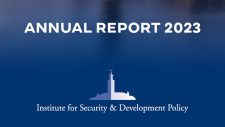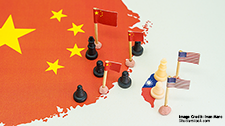A Reflection on U.S. Grand Strategy: Trump and the Challenge for South Korean Diplomacy

Ildo Hwang
Where does President Trump’s foreign policy fit within the existing paradigms envisioning America’s role in the world? Or does it represent a radical new departure? Providing a historical perspective, Ildo Hwang traces the contours and ideological underpinnings of U.S. foreign policy to the present day, as well as assesses the potential implications of Trump’s presidency for South Korea in the context of rising tensions with China.
Throughout the modern history of the United States, every incoming presidential administration has been faced with defining its foreign policy—including declaring the objective of such a policy, deciding which instruments and resources should be deployed, and how they should be organized. Debates on what is termed America’s “grand strategy” have been fiercely contested and a feature of almost all presidential elections. Understanding the historical context of these debates and the competing visions for America’s role in the world is helpful not only to understand U.S. policy-making dynamics, but also essential to predict the future direction of the international order under a Trump administration and the implications for South Korea.
Envisioning America’s Role
One of the most influential academic writers on U.S. grand strategy is Bruce Jentleson of Duke University. In 2014, he published an accomplished article in The Washington Quarterly which succeeded in delineating and classifying the arguments on the future direction of U.S. foreign policy according to three main schools of thought: retrenchment, reassertiveness, and recalibration
Retrenchment is advocated by those who see “limited” global threats on the one hand and prioritize domestic concerns on the other. Proposals include reducing defense spending, maintaining fewer overseas military bases, relying less on the use of military force, and generally pulling back from “overextension.” Proponents of retrenchment are therefore often equated with being isolationists.
Whereas retrenchment envisions the United States “doing little” in the world, reassertiveness pushes for it to do much more. Neoconservatives and other similar schools contend that it is both in the U.S. national interest and a stable world order for the United States to remain the dominant nation. Thus while retrenchment perhaps overestimates the extent to which the United States can stand apart, reassertiveness overestimates the extent to which it can play the role of global hegemon.
Differentiating itself from the two extremes above, the third school of thought espouses recalibration: that is, staying deeply and broadly engaged, but based on a reassessment of U.S. power, reappraisal of interests, and the repositioning of its leadership role geared to the geopolitical, economic, and technological dynamics, among others, driving this 21st-century world. Accordingly, American power remains formidable, but the stock-taking of “counting” power is less important than the influence strategizing of how to most effectively use it.
Another categorization regarding the future role of the U.S. in the world order is provided by Ian Bremmer, president and founder of the political risk research consultancy Eurasia Group. In his 2015 book Superpower: Three Choices for America’s Role in the World, he distinguishes between what he calls Independent America, Moneyball America, and Indispensable America. According to the Independent America thesis, it is time for Washington to declare independence from the responsibility of solving everyone else’s problems. Instead, Americans should lead by example by improving the country from within and tapping into its own latent potential.
Moneyball America, the vision advocated by Bremmer, acknowledges that the United States is not able to manage every international challenge, but asserts that U.S. interests must be defended wherever they are threatened. Proponents of such look beyond what they see as phony arguments about American exceptionalism with a more “clear-eyed” assessment of U.S. strengths and limitations. Promoters of Indispensable America, on the other hand, insist that only Washington can promote the values on which global stability increasingly depends in our hyper-connected world. Accordingly, turning inward, it is argued, would threaten America’s security and prosperity.
A Short History
While looking to America’s future role, the aforementioned spectrum of approaches can in fact be found in U.S. history after the Second World War. Notable differences between administrations notwithstanding, U.S. foreign policymaking came to be dominated by three main strands. The first was the period of the blockade strategy that started with the Cold War and continued until the 1960s; the second was the period of selective engagement epitomized by the Nixon Doctrine; and the third was the period of various proactive engagements amidst the more aggressive foreign policy of the Reagan administration.
The strategic theme throughout the early Cold War era was that of containment of the Soviet Union and its allies. With the establishment of the Truman Doctrine in 1948, American foreign policy sought to forge a strong alliance strategy, including the creation and strengthening of NATO, to prevent communist expansion. In the course of various conflicts such as the Korean War, the Berlin Blockade, the Cuban Missile Crisis, and the Vietnam War, Washington employed intense pressure, aggressive force intervention, and offensive nuclear deterrence.
Thus it can be argued that U.S. foreign policy at the time was roughly defined as belonging to the reassertiveness or Indispensable America schools of thought, as outlined above. In regard to nuclear strategy, the offensive deterrence theory model, entailing mass retaliation and mutually assured destruction (MAD), prevailed during this period. This model would evolve along with the understanding of the potentials of nuclear power, but there is no doubt that the offensive/punishment nuclear strategy was closely related to the strong U.S. containment policy or confrontation of the early Cold War era.
Put forward in July 1969, the Nixon Doctrine signaled a marked turning point in U.S. strategy. Initiating the withdrawal of American troops from Vietnam, the Nixon administration declared an “Asianization of Asian security,” started to pursue selective engagement, and, through the announcement of the Shanghai Communiqué in 1972, signaled the improvement of relations with China. The Helsinki Process in Europe, moreover, did much to attenuate Cold War tensions. The so-called age of détente had arrived.
A major document reflecting this doctrine was Nixon’s report to Congress titled U.S. Foreign Policy for the 1970’s: A New Strategy for Peace. Issued in February 1970, the main content of the report outlined the policy of reducing U.S. troops overseas and refraining from dispatching ground forces. This in effect called for the restraint of the use of U.S. military force, a call which continued to be heeded during the Ford administration and did not change much during the Carter administration, which sought to pursue a liberal value-oriented diplomacy based on human rights and democracy. Even the Korean Peninsula was influenced by this shift in the 1970s as the United States Forces Korea (USFK) was reduced and preparations even made for its withdrawal.
The Nixon administration’s pursuit of détente was based on a realistic stock-take of the international situation, and it was also characterized by a retrenchment of foreign policy. The liberal intervention of the Carter administration meanwhile could be characterized as a form of recalibration. More apt still perhaps is Bremmer’s Moneyball America categorization, whereby the U.S.’s overall orientation at the time consisted of focusing on the most efficient and effective means to achieve a clearer goal: namely maintaining stability in Europe, rather than on maximizing its national strength. Nuclear strategies such as the “flexible response strategy” in the late 1960s and the Carter administration’s “countervailing strategy,” which focused on phased/denial deterrence instead of maximizing nuclear offensive power, were also formulated around this time.
With the foreign policy of the Carter administration challenged by the Soviet invasion of Afghanistan, the Reagan administration began to push forward a strategy of pressurization that came closer to restoring the blockade policy. The focus of nuclear strategy also shifted back from defensive deterrence to offensive deterrence, which included a deployment plan of intermediate-range ballistic missiles on the European continent. For this reason, the Reagan period might be categorized as a period of reassertiveness or Indispensable America.
While the Republican and the Democratic administrations spanned various foreign policies between realism and liberalism, the position that the United States should take the lead in addressing major issues around the world became entrenched after the end of the Cold War. The George H. administration’s participation in the Gulf War, the Clinton administration’s “democracy and market economy” proliferation efforts, and the George W. Bush administration’s neo-conservatism after the September 11 attacks, could all be interpreted in this context.
However, President Obama came to power in 2009 amidst severe criticism of his predecessor’s military intervention in Iraq. The Obama administration subsequently sought to pursue a middle-way approach that combined liberalist engagement with realist recalibration. The result was a policy of minimizing intervention using ground forces, utilizing more incisive tactics like the drone program, and reducing the role of nuclear weapons in military strategy. Practical problems and limitations arose from this posture, not least the ongoing civil war in Syria which the administration attempted and failed to tackle through multilateral coordination based on international cooperation.
It is obvious that factors other than ideological orientation also bear on the foreign policy trajectory of U.S. administrations. This often includes the need to distance the new administration from its predecessor’s policy agenda so as to garner support from the electorate. The economic situation, moreover, exerts particular influence on the review process and foreign policy of the next government. Voters’ concerns about the economy often lead to a preference for retrenchment in foreign policy, which comes to influence the next administration’s direction.
President Nixon’s case is a classic example of such dynamics. His choice of selective intervention stemmed from the chronic economic deficits, inflation, and enormous trade deficits that the U.S. economy was running at that time. The fact that Nixon, an ardent anti-communist, adopted an active policy of détente illustrates how economic priorities might be a stronger factor in determining foreign policy course than the president’s individual belief or political agenda.
Economic variables can only explain so much, however. The U.S. suffered an equally, or even worse, economic recession in the 1980s due to prolonged trade deficits; but the Reagan administration chose to pursue a policy package of intensive reassertiveness, even though it simultaneously adopted protectionist measures and instruments called “new trade policy” and other import regulations.
Tracking the correlation between these trends and nuclear deterrence strategy is another point that could provide meaningful insights. The degree of an administration’s inclination toward offensive/punishment versus defensive/denial deterrence in nuclear strategy or military structure is more closely correlated with the liberal-conservative dichotomy than “orientation” vis-à-vis external engagement. While the Kennedy-Carter-Obama administrations focused more on defensive/denial strategies, Republican administrations underpinned by realist narratives have tended to adopt offensive/punishment deterrence strategies.
Whither Trump’s Foreign Policy?
During his election campaign, most of President Donald Trump’s pledges regarding foreign affairs could be characterized as retrenchment with selective intervention; in fact they could further be described as a modified form of neo-isolationism or mixture of Independent America and Moneyball America, as per Bremmer’s categorization. While seeking to represent a clear departure from Obama, Trump’s pledges also sought to tap into the discontent at the economic situation—attributed to globalization and corporate exodus—expressed by a key segment of the population. Trump accordingly campaigned on this basis, espousing American retrenchment.
Though the administration is still in its early days, its inclination or direction in terms of foreign policy is becoming more difficult to pin-point. Despite critical words during the campaign, his more recent utterances regarding NATO and the future of the U.S. alliance with South Korea and Japan have been more positive. This has also been affirmed in official statements made by his staff, such as Secretary of Defense James Mattis’s recent statements during his tour in Northeast Asia in February where he sought to reassure allies. Nonetheless, the economic variable seems to remain significant: the rhetoric employed by the Trump administration emphasizes “burden sharing” with regard to maintaining “healthy alliances.”
It can be argued that Trump faces two options regarding nuclear and military capability. One is the Reagan model: enhancing conventional, nuclear, and missile defense capacity simultaneously to maximize the country’s military readiness in terms of both denial and punishment deterrence. The other is a unique model that focuses only on deterrence by punishment through nuclear power enhancement, either in terms of quantity of warheads and vehicles or improved system efficacy through modernization programs.
Distinguishing himself from Obama, Trump’s remarks on nuclear strategy so far signal a change to offensive punishment deterrence. Indeed, his articulated posture is to strengthen and “show off” nuclear power by asserting U.S. nuclear supremacy. The administration has further pledged to strengthen military capacity including conventional forces, as well as intends to broaden missile defense deployment, in particular against Iran and North Korea. Given the cost of sustaining such, however, amidst the backdrop of economic concerns at home, serious doubts remain whether these plans will be realized in the long run.
China as Challenger
China as a challenger to the U.S.-led international order occupies a key place in U.S. foreign policy making, with Trump having already made several moves seen as exacerbating tensions with Beijing.
Much of the contemporary discussion about China’s rise has been underpinned by power transition theory, which was first developed by Organski in the late 1950s. He conceptualized a hierarchical international system in which a dominant power heads an international order. The problem arises, however, when the existing hegemon is challenged by newly industrializing nations. As Organski explained, “a recently industrialized nation may be dissatisfied with the existing international order,” with the theory predicting war or a drastic increase in tensions if an unsatisfied challenger increases in strength and begins to overtake the dominant power. Unlike the theory of balance of power, which describes the static structure, his power transition theory was influential in explaining dynamic change, and it has high explanatory power in historical cases such as the outbreak of the First and Second World Wars.
The current gap in national strength between the U.S. and China renders the power transition scenario on a global level implausible, at least for now. However, Lemke’s extension of the power transition model to the regional level, arguing that regional hierarchies also exist, poses interesting possibilities. While the dynamics of regional hierarchies may depend on the resources devoted to the region by the global hegemon—read the U.S.—in the case of Northeast Asia China has in recent years sought to increasingly assert itself in the region, dissatisfied with the existing status quo. On this basis the regional order has become more contested and unstable.
Nuclear weapons hold particular significance in transition theory. In the modern international order, nuclear capability can assumed to be the essence of military power. Cheaper than maintaining conventional military forces, a challenger can seek to bolster its nuclear arsenal as a means of rising in the hierarchy; the hegemon can similarly block the challenger in the same way. One might guess that these theoretical controversies and hypotheses may underpin Trump’s rationale for a “nuclear strengthening policy”: that is, seeking to contain China’s military challenge through nuclear means, at the same time as threatening to impose trade tariffs that may jeopardize its economic growth.
Implications for Korea
China’s challenge to the regional hierarchical order and the response of the United States has significant implications for the Korean Peninsula. In this regard, there are three possible scenarios depending on the course of the Trump administration’s military policy vis-à-vis China. If he chooses a build-up in conventional and nuclear warfare capability, as advocated in his campaign pledge, the Korean Peninsula will most likely serve as the main stage for military confrontation between the U.S. and China; the geographical position of the peninsula makes it the sole potential battlefield in terms of ground forces. If he chooses the second option that includes nuclear strengthening plus missile defense system construction, the so-called Regan model, it is feared that political tensions around the Terminal High-altitude Air Defense (THAAD) system and other missile defense components will grow in seriousness; defense secretary Mattis has in fact recently affirmed THAAD’s deployment schedule.
The scenario that he selects the third option which focuses only on strengthening nuclear offensive/punishment deterrence and ruling out denial deterrence assets like missile defense systems, could create the most favorable result for the Korea Peninsula, especially when it comes to China. As nuclear deterrence mainly concerns ICBMs and SLBMs, the geographical “advantage” of the Korean Peninsula has lower value in that grammar, especially compared to the other two scenarios, and this could make the South Korean diplomatic stance less tense.
In consideration of the above, the main task for South Korea’s diplomacy is to mitigate the consequences for the peninsula of a military buildup under the Trump administration. Unlike the Obama administration, which was hesitant about showcasing its nuclear arsenal and deploying strategic assets such as strategic bombers—this even after North Korea’s provocations—the Trump administration is more likely to take an active role as a means of seeking to contain China. The main setting for the extended deterrence consultations between the U.S. and South Korea have so far been “Korea asks for more and America hesitates”; but from now on there is high probability that the U.S. would like to utilize military drills and maneuvers against North Korea as a means of demonstrating force to China. The U.S.-ROK joint military drill starting in March may be a starting point for this. Recent news that the two governments have agreed on the dispatch of U.S. strategic assets to the drill, and that the United States Pacific Command suggested the deployment of the cutting-edge Zumwalt class destroyer DDG-1000 to Jeju Island, are strong signals in this direction.
In this vein, the most crucial challenge for Seoul is to minimize the political cost and backfire regarding its bilateral relations with China. In case of the deployment of U.S. military strategic assets in or around the peninsula, Seoul will have to clarify to China that the nature of the measures taken are intended towards Pyongyang and not Beijing, even though China does not seem to agree. And Seoul also must continue to keep a low profile regarding taking a stance on the South China Sea and Taiwan issues if bilateral relations are not to deteriorate.
The dilemma is that the concern regarding tensions with China could be in conflict with extended deterrence against North Korea: that is, minimizing U.S. strategic asset deployment would send the wrong signal to North Korea and even damage the robustness of the ROK-U.S. alliance. It is thus a difficult tightrope for South Korea to walk—one which also exposes differing considerations between the military and foreign ministry. Generally speaking, the South Korean military has a long tradition of believing “more is better” and demanding more deployments and drills by the U.S. to counter the North Korean threat. One could argue that this is prompted by a fear of abandonment. The foreign ministry, on the other hand, fears the consequences of involvement.
Both fears need to be reconciled in extended deterrence discussions with the United States, especially at the table of the U.S.-ROK Foreign and Defense Ministers’ EDSCG (2+2 Extended Deterrence Strategy Consultation Group). Having hitherto been dominated on the South Korean side by the defense ministry, the simple dogma of “more is better” can no longer guide the country’s stance in consultations in light of the emerging context. In so doing, there is a need to reinforce relevant diplomats’ expertise on the grammar and terminology of nuclear deterrence. Lessons can perhaps be drawn from the NATO NPG (Nuclear Planning Group)’s case during the Cold War in which civilian officials and experts from European countries played significant roles in talks with the U.S.
Conclusion
To conclude, recent trends—unless there is a dramatic change—portend a gloomy picture for the Korean Peninsula, especially regarding military tensions among countries. In 2016 North Korea conducted two nuclear tests, with more developments likely to follow in 2017. Should the new U.S. administration utilize this for increasing its military presence in the region, a hostile reaction from China becomes more likely. With the Korean Peninsula once again becoming a potential area of confrontation between the two giants, both in terms of economy and security, Seoul is encountering one of the most serious diplomatic challenges in its modern history. It is this unenviable challenge which the next South Korean president will have to seek to navigate.
Note: This paper derives from a speech given by the author. It has been edited for clarity.
Related Publications
-
ISDP Annual Report 2023
ISDP’s Annual Report for the year 2023. We look back on 2023, a year in which tensions and conflicts captured the strategic space in ISDP’s focus areas, making headlines around […]
-
Navigating the Indo-Pacific: How Australia and the EU Can Partner for Peace, Stability, and Prosperity
To navigate the choppy waters of the Indo-Pacific, the EU and Australia must be on the same wavelength regarding shared interests in rules, values, and an open and liberal economic […]
-
Report of the Webinar on China’s Himalayan Hustle – Part IV: EU, India, and US – Framing a Troika to Scuttle China’s Himalayan Strategy?
This report is an outcome of ‘China’s Himalayan Hustle-IV’ webinar on “EU, India, and US – Framing a Troika to Scuttle China’s Himalayan Strategy?” which was conducted by the Stockholm […]
-
China as a Black Sea Actor: An Alternate Route
China’s international role has expanded rapidly in the last decades, and the Greater Central Asian region, Europe, and the Middle East, to which the Black Sea region (BSR) connects, are […]
-
Taiwan-PRC Crisis: What Cross-Strait Conflict Could Cost Europe
The escalating tensions between Taiwan and China pose significant economic and strategic challenges to the European Union, such as the inaccessibility of Taiwanese inputs, market, and capital. This issue brief […]




